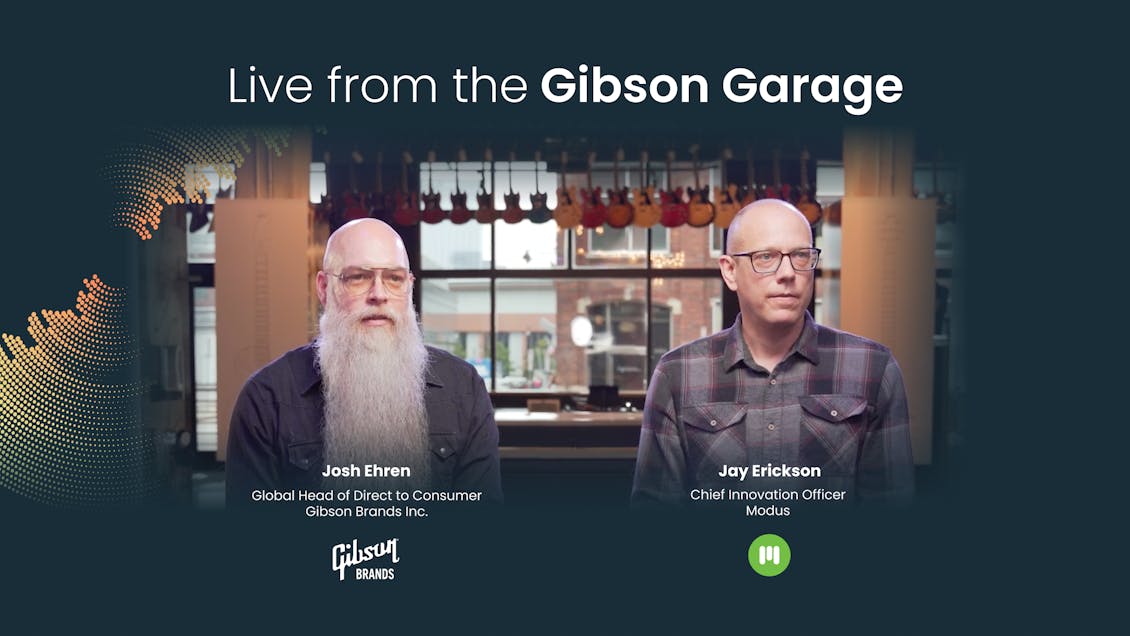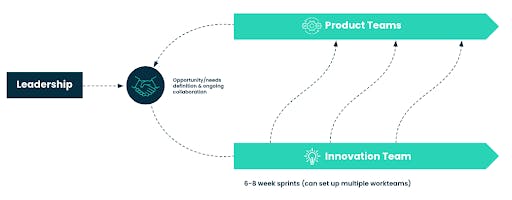Webinar recap: Turn Up the Volume on Innovation, While Rocking Operations

Don’t miss this engaging conversation on how to drive true innovation from one of the world’s most iconic music brands
Modus’ Chief Innovation Officer, Jay Erickson, recently sat down with Josh Ehren, Global Head of Omni-Experience at Gibson Brands, Inc., at the Gibson Garage headquarters in Nashville to unpack how — and why — innovation is a core strategy for the iconic music brand. Scroll down to read the full transcript.
Gibson (est. 1902) is one of the premier names in American guitars. Powered by a new management team with a huge vision, plus the pandemic-driven rebirth of guitar playing worldwide, Gibson tapped Modus to help them deliver a modern, direct-to-consumer platform and omnichannel digital experience that reinvented the brand and rocked the industry.
Modus also worked with Gibson to inject a culture of innovation and human-centered design that could drive change at the company while maintaining and highlighting the essence of its legacy: music, artists, and guitars. While there’s no one template for innovation, Gibson was open to change in realistic and achievable ways.
Josh shared that the alternative to staying innovative is to risk being left behind: “It's not about getting left in the dust from your competitors or from the market, from any of those things. I mean, yes, there's that possibility. But you will never allow yourself to be able to drive your business, and I think that's the best way I can say it. It’s that you are going to constantly be in the reactive mode. You will never be able to get the tools and/or deliver the experience that we know our fans want and need and deserve.”
“For us, I think there's such an obligation to engage [our fans] and to make sure that we are allowing and helping our fans to connect with us. Ultimately, more so than anything else, to me that's the biggest risk, is to not be able to connect with our fans. To me, that is where it starts and stops.
If you do that, if you are able to connect with your fans and constantly evolve with them and together, that's where you will win.
Modus worked with senior leadership to set up two teams within Gibson: one that worked on day-to-day digital business (ecommerce, CMS, digital marketing), and the other on a comprehensive innovation program. This structure allowed Gibson to build space for fresh thinking.

The day-to-day group, named Team Flying V after one of Gibson’s most iconic electric guitar models, focused on the core roadmap of delivering near-term growth and operational excellence. Initiatives such as streamlining the marketing tech stack, creating a component system for digital design, and launching a brand style guide all fell under this workflow. By aligning technical infrastructure, outputs such as a new landing page now only take minutes to create, helping the brand achieve its omnichannel goals faster.
The innovation group — named Team Explorer, also after one of the company’s signature guitar models — worked on six-to-eight-week sprints tied to specific concepts. Initial ideas came by consulting with company leadership and interviewing players and artists, as well as more traditional product teams and other stakeholders.
“First and foremost, you know, the recommendation I have for anyone is to understand the roadmap,” said Josh. “There are so many bright shiny objects out there. … When in reality, we're the closest to where we are. We're the closest to where we understand how we need to evolve for the sake of our fans. And we have that hyper focus.”
Once a concept was chosen, the innovation team iterated rapidly, moving from idea to MVP in less than two months. The end result was a strategic vision, a prototype for the new product or service, customer validation findings, and a business model for scaling the new innovation into profitability. During the workflow, the innovation team shared its findings and got constant feedback from the product team and executives. The rapid timeline and multiple work streams resulted in three new proprietary ideas to transform the customer experience.
Organizational ambidexterity works well for Gibson’s approach to innovation, said Josh. The company is able to handle the day-to-day needs of the business adjacent to the incubation of new solutions that address tomorrow’s challenges.
“When we have our conversations … we're able to talk about the day-to-day, we're able to talk about that forward thinking, and then we kind of always bring it back, organically,” he said. “We all have that mindset. And we're able to see the different paths that allow us to see where they need to come together, over and over.”
Thanks, Josh, for your time, for your inspiring commentary on innovation at Gibson, and for your partnership with us at Modus. Here’s to continuing to make music matter!
Full transcript:
Jay: Thanks everybody for joining us. I'm here at the Gibson Garage with Josh Ehren, Global Head of Direct to Consumer at Gibson Brands and I’m really excited to be here. I'm Jay Erickson, Chief Innovation Officer at Modus. We're here to talk about innovating at the enterprise. And I’d love for you to introduce yourself.
Josh: Yeah. My name is Josh Ehren. Like Jay said, I'm Global Head of Direct to Consumer for Gibson Brands, and ultimately what that means is that — I promise this is the last time I'll sound super corporate — you have you know, from the sales channel and enabler perspective, so sales channels, it's all the standard direct elements. So you have e-commerce, you have the Gibson Garage, our flagship store here in Nashville, Tennessee, you've got marketplace, you've got partnerships sales, so artists sales, you know, industry sales, etc. And then it’s the enablers that go along with that. So, technology, you've got performance marketing, that consumer experience and customer service.
Jay: So, innovating at the enterprise is, it's hard right? You're at an enterprise, you're tasked with doing the daily, keeping operations going, and you're also tasked with doing neat stuff, innovative stuff. So in your career, how do you manage that tension?
Josh: Yeah, and it's — tension is the right word. Right. And I think it really starts with how you speak to it internally and how you focus on it internally. I think one, it starts with the differentiation between your calendar and your roadmap, right? They are two definitively different things. Your calendar is utilizing exactly what you have in order to continually make your updates based on the business. Then you have your roadmap, which is again, that's where it's more that forward thinking. So it's ultimately understanding what you need to accomplish based on what your daily is, how it's performing. And so, to me, that is immediately how I tried to help differentiate because then it's two definitively different conversations that go together.
And so, in retail, it’s really easy to get into that circular inertia of the day-to-day, right. And if you don't have your eye out here, then you're always going to be playing defense. Because ultimately, I think what it comes down to is making sure that you are able to utilize your daily to inform your roadmap, build the roadmap to come over to your daily, right. And I think that far too often, it's one conversation, which means you don't get anything done. To me, that's how I tackle it, because ultimately, innovation, technology, tools, etc. — those are the enablers to your business. Right? And so that's how I've always looked at it. That's how we really kind of focus on how we make decisions. Both from that daily versus the longer term type of data.
Jay: So it was not just about getting an unending state of responsiveness to the data, but using it as a source of information to help guide this other parallel processes of a roadmap.
Josh: Yeah, yeah, that's exactly it. The way that I kind of speak to it is in retail, first you act, then you react, and then you act, and then hopefully, you can become more proactive. And what I mean by that is, you know, you put your strategies together, you go live with whatever the initiative is, and then you'll immediately see the results, right? That's the beauty about what we do with direct-to-consumer, you can immediately understand what's working and what is not and or what you can optimize, right? And I think that's the reactive and then you make the call, right and then and then you go live with that. So that's the act again, you keep looking at that performance and understanding. Okay, so here's some of the patterns that we've been seeing. So you can now become more proactive. That's what comes back to help inform what your what your roadmap needs to be. Right?
And so if you don't look at it in that way, you will constantly be in that circular motion of just reacting, reacting, reacting, and then you'll never be able to have that forward thinking and or roadmap focus that you know you need that will allow you to become more efficient in everything you do.
Jay: So what are the risks of not innovating for a brand like Gibson?
Josh: I would say for any brand. The risk is that you will get left in the dust, right? It's not about getting left in the dust from your competitors or from the market, from any of those things. I mean, yes, there's that possibility. But you will never allow yourself to be able to drive your business, and I think that's the best way I can say it. It’s that you are going to constantly be in the reactive mode. You will never be able to get the tools and/or deliver the experience that we know our fans want and need and deserve because we're constantly over here. So that's the risk.
The risk is ultimately — I’m not even going to go into the business aspect of it, because that's not how we try to speak to it. The beauty of Gibson and the beauty of a lot of different brands is that your fans either love you or obsess with you or your brand or products etc. We are extremely fortunate to have fans that are so in love with our brand and products and a lot of times obsessed with those brands and the products.
And so for us, I think there's such an obligation to engage them and to make sure that we are allowing and helping our fans to connect with us. Ultimately more so than anything else, to me that's the biggest risk, is to not be able to connect with our fans. To me, that is where it starts and stops. If you do that, if you are able to connect with your fans and constantly evolve with them and together, that's where you will win. Everything else will take care of itself. If you can't find ways to continually engage with your fans, that’s where you lose.
Jay: That relationship is obviously so important, and like with any relationship, it needs to be fed, it needs some new stuff to keep it alive.
Josh: Look, what works today won't work tomorrow. And what worked two weeks ago won't work in a month, you know, two months, a year, two years, right. And so, you're absolutely right. So if you don't keep your eye on that, again, you run the risk of just being left behind. And that's not the place anyone wants to be, obviously.
Jay: So what are some of the ways that you're keeping the newness and driving innovation here?
Josh: Yeah. I mean, if you think about it, the direct-to-consumer business is actually relatively new for Gibson, right? You know, and I've been at a lot of different places. I've had the fortunate opportunity to work at a lot of heritage-type brands throughout my career. Prior to being at Gibson I was in Harley Davidson prior to that I was at VF Corporation. These are heritage type brands that are based on traditional business models.
And so a lot of times it's for lack of I would say, and I mean clearly I’m being a little dramatic when I say this, is how are you able to go into the new path of direct-to-consumer, right? How are you able to evolve your business into that, because ultimately, the direct-to-consumer business if you ask me, first and foremost, the number one KPI and I'll say this until no one wants to work with me anymore, is to support the entirety of the business. To me, that is the number one KPI that we have to focus on. It is not converting on the site. It's not converting in the Garage. It's not getting people to a marketplace channel. It is to help support the business right?
If we can get consumers, and when we speak to it, if we can get our fans to interact with us in various channels in various ways, we know that we have a stronger opportunity to have those connections with our fans. And so that's how we look at it first and foremost from Gibson. And ways that we're innovating here is, first and foremost, you know, the recommendation I have for anyone is to understand the roadmap. There are so many bright shiny objects out there. It is so easy to chase, and to chase, and to chase. How many emails do we all get every single day with people saying ‘Hey, we can increase this, we can do this.’ You have all of these bright shiny objects, when in reality, we're the closest to where we are. We're the closest to where we understand how we need to evolve for the sake of our fans. And we have that hyper focus.
If you don't have that hyper focus, you're gonna again, be chasing, chasing, chasing. So to me, that's the number one thing. Second element that works really well for us is, to be perfectly candid, it’s the way that we work with Modus, which is, we have two distinct paths, right? We have — Gibson terms here — we have Team V, and we have Team Explorer.
And so with Team V, that's that ongoing how we're going to continually drive the day-to-day business. And then Team Explorer is really coming down to how can we make some leapfrogs? How can we actually look at this where we have a separate path that is working so it's informed from over here. We bring it over here, we build what we need, and then we bring it back. Right? And so for us that's been working really well because it allows us to keep our eyes on both paths simultaneously. There's a lot of ways you could do this, but for us it works really well in this way because again, we can have that hyper focus in both lanes at the exact same time and understand when they have to come together.
Jay: Yeah, that's right, and that's our thesis too, having worked with enterprises for 20 years and trying to do innovation sort of incrementally within the existing workstreams, you know, led us to the point where a few years ago we launched this innovation-as-a-service program. So we’re saying you really have to separate this out and use the sprint mentality and the lean mentality to say, we can do a lot of stuff in two months, you know, that at the enterprise people would expect to take 12 months or 18 months. And we can do this using techniques from the lean startup world. How have you found that, working through our process of what are we trying to solve for, what’s the vision, and into sort of validated prototypes?
Josh: I mean, again, it really comes down to — and again you know, I hate the word innovation, too. Because it can become meaningless, right? Sure. And I think that theater is right. And I think it comes down to how you speak to it. Innovation is not technology. Right? I think that's the number one thing that I always try to come down to — innovation is not technology. Innovation is understanding how to work through whatever scenario that you have to work through. To me, that's what it is. Technology can help enable it. But you have to have that mindset first and foremost.
And so, for us, getting back to your question… I think the sprint mentality without question makes the most sense, right? Because ultimately, what you're able to do is you're able to see where you can get some of those wins. And it's not just a win that you get immediately. It's a validation. Because again, anytime you use the word innovation, it's like you're trying to solve for something. That’s not a straight line.
And so ultimately, I think it really comes down to, in those sprints, it's like, we just validated the first element. Now, let's go to the next, and then the next, and the next. And so, that can be on one specific element on the roadmap, and it can be multiple elements of the roadmap. And so that's how we look at it, right? It's like, let's keep validating. Let's figure out where it makes sense. Bring some things back over here so we can actually incorporate into the day-to-day. Let's keep coming back over here. And so the thing I love about it is that — this is gonna sound a little strange — but when we have our conversations, it’s a little bit of a unique scenario of we're able to talk about the day-to-day, we're able to talk about that forward thinking, and then we kind of always bring it back, organically, right? Like it just happens because we all have that mindset. And we're able to see the different paths that allow us to see where they need to come together over and over. And so that's what I love about the sprint mentality too.
Because if you go to the old school waterfall, you won't know if something works for potentially two years down the road. And I've been in those situations where it's a full-blown waterfall approach, and we've realized that we just literally wasted two years and a whole lot of dollars.
We don't know what's going to work in two months, let alone two years.
Jay: Yeah, the environment, research and technology, and general disruption. So what does success look like for Gibson, in maybe like five years, of how your consumers are relating to you in really new ways than they have been for the past 140 years?
Josh: Yeah. I think it first and foremost starts with our overall approach for Gibson. And I know this might sound cheesy, but it's really not. It is at the core of everything that we do. The way that we originally started talking about it, and I adapted it to the Josh way of speaking to it, which is, ‘continue to make music matter.’
You know, we started by saying you know, ‘make music matter.’ And I'm like, well, music has always mattered. I think you know being someone that has been a part of the arts community literally my entire life, it is so unbelievably important to my entire existence. Right and I mean that without dramatic effect, it is very true. And so, for us at Gibson it’s to continue to make music matter.
So again, it comes right back to, how we are able to keep engagement with our fans. We are on the spectrum, it's kind of an interesting place to be, right? We have some of our fans who have never touched a guitar in our lives, but they are so deeply rooted in music culture, that it is truly part of them. Then you go all the way to the opposite end of the spectrum, and we work with the greatest artists in the world. And then it's everything else in between.
So our obligation is to constantly look for ways to connect with that entire set of fans. Then, if we really get down to more actionable, how are we able to continue to make music matter for all of those folks? So if you think about the people that have never touched a guitar or are just starting to play, we really wanted to focus our app on helping them learn how to play guitar. Take away the big chunky elements of ‘I can't do this,’ right? Like we want to get that out of the mindset. And say, look, it's actually not that bad when you just start with doing this, and then this, and then this, right, because otherwise it's very intimidating.
And so, you know, you can kind of start with the app. And then it's understanding all the way through, right. So then if you just look at all the different channels and tools that we have to work with, it's the site experience, it's helping you understand which guitar. It's the content that kind of goes along with that. Because there's a lot of guitars out there, right? So how do we help you make those types of purchase decisions?
It's also Gibson TV. You know, Gibson TV, for anyone who has not seen anything that we've done, it is truly award-winning content. And I don't even like calling it content because it makes it sound super dry. It is engaging, cool a** shit. How's that? And it is absolutely amazing because that level of storytelling that we do that that team does, is so outstanding. Because it's everything from how guitars are made, and how we make our guitars, to how to maintain your guitar, how to keep it in tune. Then, like the collections from our artists, you know, it runs the gamut. It's ways to keep you engaged and enthusiastic about guitars, music, music culture, our artists, etc.
I would be remiss if I didn't talk about our dealer partners. Because that is an element that again to go all the way back so as I was talking about what's the number one KPI for direct-to-consumer, it’s to support the entirety of the business. That is absolutely imperative for us. We have an amazing group of dealer partners, and I say that very specifically because they are partners.
And you know, everyone tries to understand what our secret sauce is on how we can do anything, and in this case, how you can connect with your dealer partners. I'll let you in on a really, really, really big secret. It's communication. It's actually partnering. It's talking, it's coordinating. Right? That's our secret sauce. It's as simple as that. There's not a single innovative thing in that except for the fact that we do it, which is potentially innovative for a lot of different industries, right? But that’s what it is. We don't see them as anything other than partners with us. And I think that's so important because they are such amazing arms to everything that we do, and in other ways that we connect with our consumers.
Then you go all the way to the Gibson Garage. We're actually sitting in a portion of the Gibson Garage right now. It's our flagship store in Nashville. And if you ask me, it is without a doubt the greatest retail experience out there. Not in the industry. Period. That's a bold statement. And I would invite anyone, no joke, anyone to come to the Gibson Garage and prove me wrong. So much so that we invite our dealer partners here. It is as much theirs as it is ours. And that's how we look at it. And every single time that you know, someone comes in, it's like they get it.
And so at the Gibson Garage… There's a chance that if we didn't do it right, that it could have been very intimidating for certain people to walk in. Right? If I don't play guitar, and I come into a music store, that can potentially be really intimidating. We cut that out from the jump. So we actually have areas where you can plug in and have your earphones on, and pick up a guitar, and through our app start to learn how to play guitar, right here at the Gibson Garage. And so we have the full breadth of assortment for all of the Gibson family of brand products as well. It's probably some of the best selection that you're going to find anywhere.
And so yes, it's every type of price point, but more importantly, it's products that fit any type of player. Whether you're starting, or you’ve been playing literally your entire life. You can even go into our Custom Shop room, and we have a wood wall where you can literally choose the piece of wood and we will make a guitar out of that specific piece of wood for you. We check your neck profiles, you choose your hardware, your finish, your everything, and we will ship it to you once it’s done.
And we have a full stage and so we have events, we have concerts, it's a huge live stream opportunity. So you know I can't speak enough to that. And that doesn't even touch the historical guitars that we've had here. It doesn't even touch the storytelling of what made Gibson Gibson, what made Epiphone Epiphone, that is here as well. And so if you look at all of those different elements, if these are all working together, to me, that success. It is literally as simple as that.
Now a lot goes into making those things work, right. Everything that we've talked about helps make all of those elements work independently and also more importantly, together. So for me, connecting with our fans, always in different ways, and utilizing all of these different types of experiences is what will ultimately continue to help us win.
Jay: Right. And what I'm hearing in that too, is what success looks like in five years, is really healthy relationships with your fans and your dealer partners. It's really striking to hear. We’ve worked with a lot of companies that have moved through the DTC journey that have not been able to get out of that mentality of like, ‘Well, I'm doing something over here. I'm not going to really talk about it [with partners].’ And be able to just say no, we're all in this together. This is all about music and great guitars and healthy relationships all around, and come to our store, as opposed to, ‘Shh — this is a thing on the side we’re not supposed to tell you about.
Josh: Yeah, that's exactly it. And I mean, I'm gonna sound a little corporate for a second, but it's just like, you can have a channel strategy. Channel strategy goes into this, of course. So we can have exclusives here, they can have exclusives there. They can offer this, we can offer that. But again, I think it's the harmonization more so than seeing anything as an enemy. I think that it shouldn't be a new mindset. It shouldn't be a unique mindset. But a lot of times it is. And if you can immediately start to break down those barriers with just normal communication and coordination, ultimately, our fans will benefit.
And music itself will benefit… To me, one more really important point is, when we say continue to make music matter, that means continue to, on top of everything else, keep people playing guitar. Keep people wanting to play guitar. And I always say it's really easy to sell a guitar. It's easy to sell a motorcycle. It's easy to sell a jacket. It's easy to sell whatever you're selling. It is a lot harder to keep them playing, to keep them riding, to keep them wearing the jacket. And I think that is the element that everything that we do from our roadmap on how to connect with our fans, that's at the core.
Because again, acquisition, everyone can kind of do it. Retention is where it gets really tricky and really hard very quickly. And that's why we focus so much on how to just connect with our fans. Because then we will make it that much more enjoyable and make them want to keep playing music, listening to music, and become part of the music culture. And ultimately, again, not to sound overly dramatic, but if we can do that, then we are truly bettering the world. And I mean that very sincerely, and that’s what excites me every single day.
Jay: Yeah, and invest in that lifetime relationship. Investing in them, investing in their craft, or if it's a hobby, whatever level it is, the more they're invested, the more they're going to invest, they're going to trade up on a guitar that’s meeting them at their new level. So, just one more question. So, you know, there's a lot of folks that are watching this are trying to do innovation or trying to do new things at the enterprise and meeting a lot of headwinds. What's your sage advice for them?
Josh: So it's hard, right? It's hard because, you know, anytime you go into your planning sessions for whatever, whether it's the beginning of this next year or whatever, it's hard. It's hard because, you know, everyone is trying to be as profitable as possible to drive your business as much as possible. And unless you’re careful, you will immediately again go into that, ‘What's the day-to-day so we can just deliver what we know we need to deliver.’ Like that. My advice is to again, flip the conversation. Flip the conversation with yourself, with your team, with your leadership team, and talk about that understanding of what is needed.
Now, it's a whole lot easier to have those conversations when you have some kind of data to back it up, right? No one wants to make a big decision on gut feels. So use your data to your advantage. It’s not even about making your case. Help have a better conversation. And I think that's really what it comes down to, if you can help make that better conversation a stronger conversation of understanding the importance. Not just this finite amount of time, but how it takes this amount of time forward, and how you're setting yourself up constantly for the betterment, it’s a much different, and a much easier way to get that ultimate buy-in. Whether it's just from that approval, budget, etc.
So use your data, have a better conversation, and that will immediately help drive whatever you need to in order to keep that path going forward. It all goes back to storytelling.



